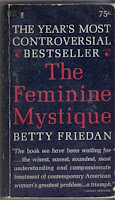 Betty Friedan’s classic started with a survey of her college classmates some years after graduation. Fortysome years later, a book about The Feminine Mystique is starting out with a survey too. This just in from esteemed marriage scholar and friend Stephanie Coontz. Please pass it on — the survey is for younger women who came across the book in Women’s Studies courses as well as for those who read it when it first came out!
Betty Friedan’s classic started with a survey of her college classmates some years after graduation. Fortysome years later, a book about The Feminine Mystique is starting out with a survey too. This just in from esteemed marriage scholar and friend Stephanie Coontz. Please pass it on — the survey is for younger women who came across the book in Women’s Studies courses as well as for those who read it when it first came out!
Writes Stephanie:
Thank you for agreeing to help in my study of the influence of Betty Friedan’s 1963 book “The Feminine Mystique.” I am trying to get a feel for how people in different time periods and situations reacted to this book, or merely to the general idea of a “feminine mystique,” whether or not they actually read the book. I have listed some questions below, but feel free to tell me anything you feel would be useful, and in as much detail as you choose.
If you heard the concept of “The Feminine Mystique” before — or without — reading the book, how and when did you hear of it? What did it mean to you? How did you react to the idea that there was a “feminine mystique”? Did a relative, spouse or friend read the book, and if so, what was their reaction? Did their reaction affect you in any way?
For people who read the book, can you tell me the year when you read it? Your age at the time? Were you married? Any children? Did you work for pay at the time? If so, at what? How did you come to read it?
Do you remember your overall reaction to the book? Did anything speak powerfully to you? Did anything anger you? What is your most vivid memory of reading it? Did it influence your life or relationships in any way?
Have you ever re-read the book? If so, why? Did your reaction change?
What is your ethnic or racial and socioeconomic background? Your current age and occupation? May I identify you by name if I quote from your response? Unless you explicitly give me permission to use your name in my book, I will not do so, nor will I offer details that might identify you.
I deeply appreciate any help you might give to this project. If there are questions I should have asked but neglected, please let me know that too. And if you have suggestions for other people I might contact, please let me know. You can e-mail your responses to coontzs@gmail.com










